Naebang-gasa
Type
Gihaengga-ryu (紀行歌類)
It is one of Gasa-ryu (type) that records trips and impressions from them. It expresses the reason of going on a trip, the appearance at the time of departure, the scenery of each region and lonesome feelings as a traveler.
Gwanhaega
 Gwanhaega / The year of Eulmi (1895 or 1955) / 23.2×281.3㎝
The lyrics is about a travel and sings about the scenery and mood from a trip (遊行) to the sea during the Lantern Festival in April in the year of Eulmi. It sings about 30 people who participated in the “Kwanhae (觀海)” Nori and describes fishing boats and auctions. There are some names mentioned here such as “Goesinamsil, Wongunamsil, and Sangwonisil.”
Gwanhaega / The year of Eulmi (1895 or 1955) / 23.2×281.3㎝
The lyrics is about a travel and sings about the scenery and mood from a trip (遊行) to the sea during the Lantern Festival in April in the year of Eulmi. It sings about 30 people who participated in the “Kwanhae (觀海)” Nori and describes fishing boats and auctions. There are some names mentioned here such as “Goesinamsil, Wongunamsil, and Sangwonisil.”
Gwanhaerok
 Gwanhaerok / 1900’s / 25.8×438.4㎝
The writer talks about feelings from an outing to “Gwanhae (觀海)” with five friends. She stares at the sea and laments their aging with gray hair.
Gwanhaerok / 1900’s / 25.8×438.4㎝
The writer talks about feelings from an outing to “Gwanhae (觀海)” with five friends. She stares at the sea and laments their aging with gray hair.
Guwolhyangsanga
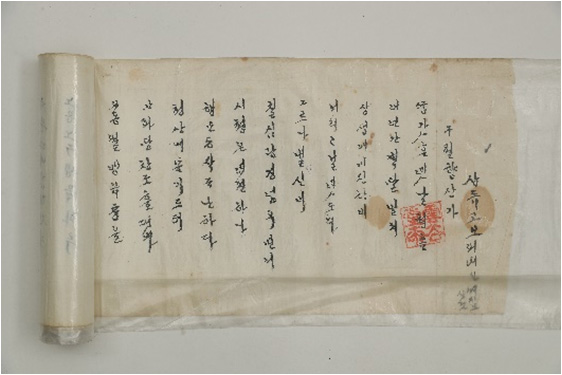 Guwolhyangsanga / Mid 1900’s / 24.6×1311.2㎝
The lyrics are about when the writer visits her parents on September 9th. She praises the virtues of her ancestors and parents. Names such as Seoaksan Mountain and Yeongnamsan Mountain in Andong are revealed. At the end, the transcriber is mentioned as “Aunt Sangdyu wrote the lyrics."
Guwolhyangsanga / Mid 1900’s / 24.6×1311.2㎝
The lyrics are about when the writer visits her parents on September 9th. She praises the virtues of her ancestors and parents. Names such as Seoaksan Mountain and Yeongnamsan Mountain in Andong are revealed. At the end, the transcriber is mentioned as “Aunt Sangdyu wrote the lyrics."
Daphaengga and Others
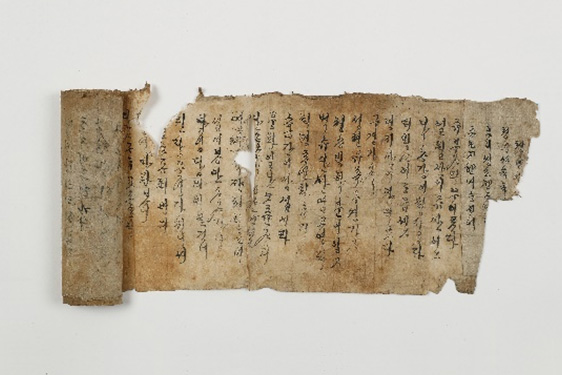 Daphaengga and Others / 1913 / 21.3×1106.8㎝
One scroll includes this piece along with “Cheongyangsanga.” It is a response to Cheongyangsanga and shows well the scenery of the mountain and her feelings from it.
Daphaengga and Others / 1913 / 21.3×1106.8㎝
One scroll includes this piece along with “Cheongyangsanga.” It is a response to Cheongyangsanga and shows well the scenery of the mountain and her feelings from it.
Ryuramga
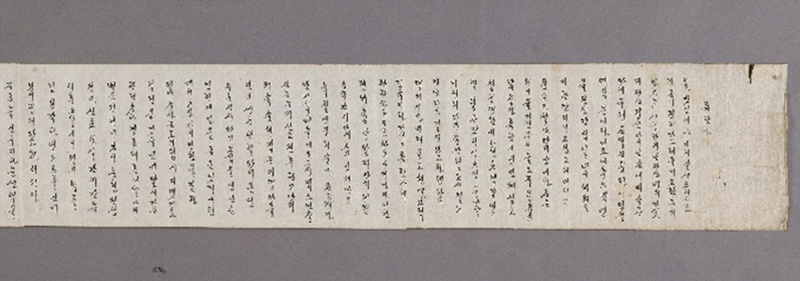 Ryuramga / 1973 (The year of Gyechuk) / 22.7×390.0㎝
It is about a trip of 57 people in Gyeongju area during spring. The piece portrays the business of their departure and includes the names of regions on the route such as Andong, Gunwi, Uiseong, and Yeongcheon. She also portrays the scenery of Royal Tomb of King Taejong Muyeol, museums, Emile Bell, Anapji, Bulguksa Temple, Seokguram, Daegu Dalseong Park, and Andong Musil Village and expresses her feelings from the destination.
Ryuramga / 1973 (The year of Gyechuk) / 22.7×390.0㎝
It is about a trip of 57 people in Gyeongju area during spring. The piece portrays the business of their departure and includes the names of regions on the route such as Andong, Gunwi, Uiseong, and Yeongcheon. She also portrays the scenery of Royal Tomb of King Taejong Muyeol, museums, Emile Bell, Anapji, Bulguksa Temple, Seokguram, Daegu Dalseong Park, and Andong Musil Village and expresses her feelings from the destination.
Mangwolga
 Mangwolga / 1864 / 24.0×251.5㎝
It takes a prose format and the author is unknown. The author reminisces the feelings from sitting in the middle of a quiet mountain alone and seeing the bright moonlight in bamboo windows (竹窓). The author thinks of the Chinese ancient poetry and characters related to the moon, plays the lyre without strings, and prepare Guibargisul and snacks and enjoy the time with friends.
Mangwolga / 1864 / 24.0×251.5㎝
It takes a prose format and the author is unknown. The author reminisces the feelings from sitting in the middle of a quiet mountain alone and seeing the bright moonlight in bamboo windows (竹窓). The author thinks of the Chinese ancient poetry and characters related to the moon, plays the lyre without strings, and prepare Guibargisul and snacks and enjoy the time with friends.
Ilwolsanga
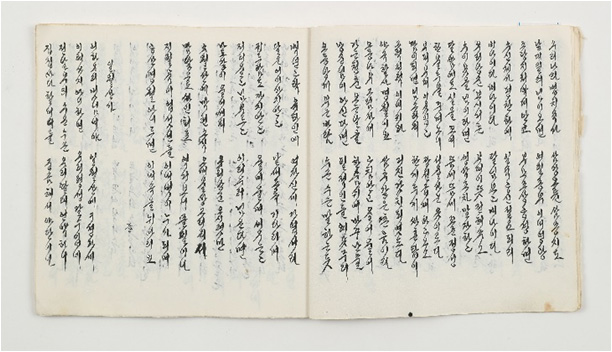 Ilwolsanga / 1925 / 23.5×23.6㎝
It is one of the early pieces written by Eunchon (隱村) Cho Ae-young (趙愛泳) at her age of 15 along with Sanchonhyangga. She sings about an episode of going out with other women to harvest herbs at the foot of Ilwolsan Mountain in her hometown of Jusil Village, Yeongyang, in spite of scolding of other adults of the family. It introduces the folk tales that King Yeongjo could enjoy longevity with Geumjuk herb from Ilwolsan, and praises the virtues of her ancestor Okcheon Cho Deok-rin in the Joseon Dynasty and accomplishments of the Hanyang Cho family. In the last part, she overlooks East Sea from Iljabong (日字峰), the highest peak of Ilwolsan, regretting the Japanese colonial period.
Ilwolsanga / 1925 / 23.5×23.6㎝
It is one of the early pieces written by Eunchon (隱村) Cho Ae-young (趙愛泳) at her age of 15 along with Sanchonhyangga. She sings about an episode of going out with other women to harvest herbs at the foot of Ilwolsan Mountain in her hometown of Jusil Village, Yeongyang, in spite of scolding of other adults of the family. It introduces the folk tales that King Yeongjo could enjoy longevity with Geumjuk herb from Ilwolsan, and praises the virtues of her ancestor Okcheon Cho Deok-rin in the Joseon Dynasty and accomplishments of the Hanyang Cho family. In the last part, she overlooks East Sea from Iljabong (日字峰), the highest peak of Ilwolsan, regretting the Japanese colonial period.
Cheongryangga
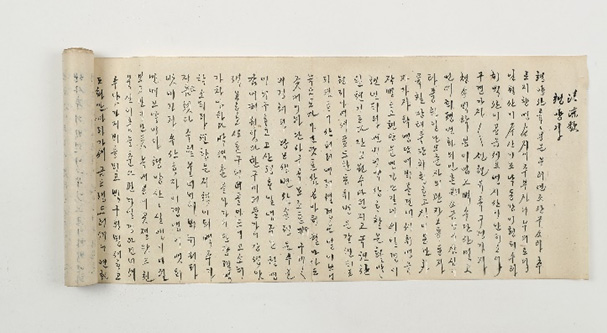 Cheongryangga (淸凉歌) / 1930 / 25.7×455.0㎝
The lyrics are about the beauty of the scenery and impressions from it when the writer went on a trip to Cheongryangsan Mountain in Bonghwa. She says that the scenery of Cheongnyangsan, which is extended from Ilwolsan Mountain and is harmonized with Nakdonggang River Changhaesu, is superior to other famous mountains. At the end, the transcription date is indicated as “the fifteenth day of the third month in the year of Gyeongo.”
Cheongryangga (淸凉歌) / 1930 / 25.7×455.0㎝
The lyrics are about the beauty of the scenery and impressions from it when the writer went on a trip to Cheongryangsan Mountain in Bonghwa. She says that the scenery of Cheongnyangsan, which is extended from Ilwolsan Mountain and is harmonized with Nakdonggang River Changhaesu, is superior to other famous mountains. At the end, the transcription date is indicated as “the fifteenth day of the third month in the year of Gyeongo.”
Cheonsanbyeolgok
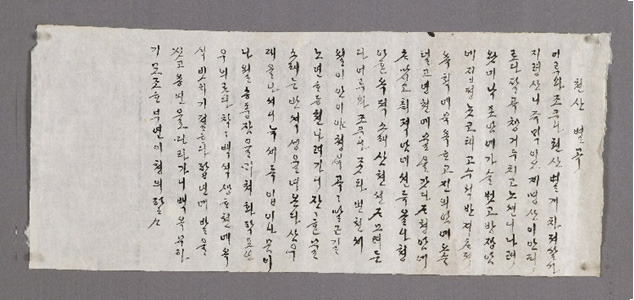 Cheonsanbyeolgok / Early 20th century / 23.5×55.5㎝
The lyrics are about the beauty of Cheonsan Mountain (Cheonjigapsan), located in Goran-ri, Gilan-myeon, Andong-si, Gyeongsangbuk-do. Overlooking Jiryeongsan Mountain and Gyemyeongsan Mountain, the writer expresses the feelings from looking at rocks such as Nakpoam, Bangjangam, Jineuiam, Jacheongam, and Chuijeokam and Samudae and Gwanakyeon.
Cheonsanbyeolgok / Early 20th century / 23.5×55.5㎝
The lyrics are about the beauty of Cheonsan Mountain (Cheonjigapsan), located in Goran-ri, Gilan-myeon, Andong-si, Gyeongsangbuk-do. Overlooking Jiryeongsan Mountain and Gyemyeongsan Mountain, the writer expresses the feelings from looking at rocks such as Nakpoam, Bangjangam, Jineuiam, Jacheongam, and Chuijeokam and Samudae and Gwanakyeon.











